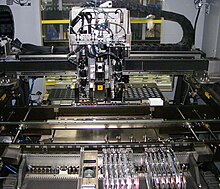Pick-and-place machine
This article needs to be updated. (February 2010) |



SMT (surface mount technology) component placement systems, also called pick-and-place machines[1] or P&Ps, are robotic machines which are used to place surface-mount devices (SMDs) onto a printed circuit board (PCB). They are used for high speed, high precision placing of broad range of electronic components, like capacitors, resistors, integrated circuits onto the PCBs which are in turn used in computers, telecommunications equipment, consumer electronic goods, industrial equipment, medical instruments, automotive systems, military systems and aerospace engineering.
The systems, also commonly called pick and place machines, normally use pneumatic suction nozzles, attached to a plotter-like device to allow the nozzle head to be accurately manipulated in three dimensions, each nozzle can be rotated independently.
Surface mount components are placed along the front (and often back) faces of the machine. Most components are supplied on paper or plastic tape, the tape reels are loaded onto feeders mounted to the machine. Larger integrated circuits (ICs) are sometimes supplied arranged in trays which are stacked in a compartment.
Through the middle of the machine there is a conveyor belt, along which blank PCBs travel, and a PCB clamp in the centre of the machine. The PCB is clamped, and the nozzles pick up individual components from the feeders/trays, rotate them to the correct orientation and then place them on the appropriate pads on the PCB with high precision. Most placement machines can optically inspect components on picking, to ensure that the correct component has been picked, that it has been picked successfully and that it is in the correct orientation. The components may be temporarily adhered to the PCB using the wet solder paste itself, or by using small blobs of a separate adhesive, applied by a glue dispensing machine.
1980s and 1990s
During this time, a typical SMT assembly line employed two different types of pick and place (P&P) machines arranged in sequence. The unpopulated board is fed into a rapid placement machine. These machines, sometimes called chip shooters, place mainly low-precision, simple package components such as resistors and capacitors. These high-speed P&P machines were built around a single turret design capable of mounting up to two dozen stations. As the turret spins, the stations passing the back of the machine pick up parts from tape feeders mounted on a moving carriage. As the station proceeds around the turret, it passes an optical station that calculates the angle at which the part was picked up, allowing the machine to compensate for drift. Then, as the station reaches the front of the turret, the board is moved into the proper position, the nozzle is spun to put the part in proper angular orientation, and the part is placed on the board. Typical chip shooters can, under optimal conditions, place up to 53,000 parts per hour, or almost 15 parts per second.[citation needed]
From the high speed machine, the board transits to a precision placement machine. These pick and place machines use high resolution verification cameras and fine adjustment systems via high precision linear encoders on each axis to place parts more accurately than the high-speed machines. Furthermore, the precision placement machines are capable of handling larger or more irregularly shaped parts such as large package integrated circuits or package inductor coils. Unlike the rapid placers, precision placers generally do not use turret mounted nozzles and instead rely on a gantry supported moving head. These precision placers rely upon placement heads with relatively few pickup nozzles. Parts are picked up from tape feeders or trays, scanned by a camera, and then placed in the proper position on the board. The margin of error for some components is, in many cases, less than half a millimeter (less than 0.02 inches). The process is a little slower than rapid placement, necessitating careful line balancing when setting up a job, lest the precision placement machine become a production bottleneck.[citation needed]
2000 to present
Due to the huge cost of having two separate machines to place parts, the speed limitations of the chip shooters, and the inflexibility of the machines, the electronic component machine manufacturers abandoned the technique. To overcome these limitations they moved to an all-in-one modular, multi-headed, and multi-gantry machines that could have heads quickly swapped on different modules depending on the product being built to machines with multiple mini turrets capable of placing the whole spectrum of components with theoretical speeds of 136,000 components an hour. [2]
See also
Manufacturers
High End
- Universal Instruments Corporation
- Fuji
- Siemens
- Assembleon
- Panasonic
- Hitachi formerly Sanyo
Entry Level
References
